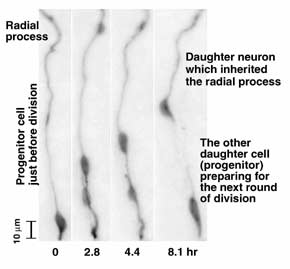  |
 |
 |
Progenitor
Cell Division Captured in Culture
Laboratory for Cell
Culture Development |
|
 |
 |
Fig. 2
|
The electrical activities
of neurons in the brain are the foundation of brain function. In areas where complex
information processing is performed, such as the cerebrum and cerebellum, neurons
are stacked in a particular order, forming layers similar to stories of a building.
When some neurons are missing or arranged inappropriately, the brain does not
function properly. Understanding the principle of the formation of brain structures
is significant to clarifying human neurological diseases, which may pave the way
to developing regenerative therapies for damaged brain tissue.
Events related to the formation of brain tissue have been conventionally studied
using fixed specimens. This method, however, has two limitations with respect
to resolution. For example, such specimens are not live and real-time observation
is not possible and furthermore, cells cannot be observed individually. It is
analogous to watching the progress of building under construction from a distance
every month; you can readily observe that the building is getting taller, but
cannot concretely understand the process details of how each material is assembled
(Fig.1).
The Laboratory for Cell Culture Development has developed a unique method of tissue
culture by which brain construction, i.e., the process from the appearance of
neurons to the formation of a neuronal layer, can be observed continuously using
living cells. Furthermore, it enables the study of cells not as a group, but individually.
The cerebral primordium was cut into sections, then cells in a section were labeled
with red fluorescent dye, DiI (Fig.1). Subsequently, progenitor cells which develop
into neurons appear individually. In this manner, the process of division for
each cell was observed (Fig.2).
Using this method, we clarified for the first time that a progenitor cell divides
while maintaining an extremely long radial process, which is faithfully transmitted
to a daughter neuron. A neuron then uses the inherited radial process as the means
to move and arrange itself at an optimal position. Our findings therefore indicate
that the production of neurons and the proper stacking of neurons are tightly
linked through the inheritance process. Our team is working to uncover the secrets
of brain formation using tissue culture methods which enable observation of live
cells individually. |
Takaki Miyata, Ayano Kawaguchi, Hideyuki Okano, Masaharu Ogawa
Asymmetric inheritance of radial glial fibers by cortical neurons.
Neuron 31, 727-741, 2001 (September).
 |
Fig. 1
|
|
 |
 |
|
|






